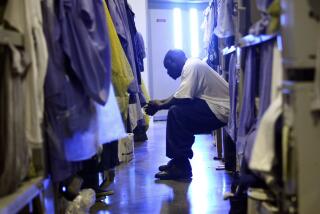State to transfer some inmates
SACRAMENTO — Tens of thousands of felons convicted of nonviolent crimes would serve their time in county jails instead of state prisons under a law signed by Gov. Jerry Brown on Monday evening.
The measure is designed to reduce the number of inmates in California’s chronically overcrowded state lockups and keep relatively low-level offenders closer to their homes, where drug treatment and mental health services are believed to be more effective.
Supporters hope to save taxpayers money by lowering the number of offenders who return to prison and by housing many parole violators in less expensive county jails.
“For too long, the state’s prison system has been a revolving door for lower-level offenders and parole violators who are released within months,” Brown said in a news release. “Cycling these offenders through state prisons wastes money, aggravates crowded conditions, thwarts rehabilitation and impedes local law enforcement supervision.”
But Brown said the program would not begin until the state has money -- hundreds of millions of dollars -- to transfer to local authorities to defray the costs.
Much of that funding was expected to come from the governor’s proposed renewal of several tax hikes that will have expired by the July 1 start of the new budget year. His attempts to get the taxes on a ballot for voter approval, as he promised while running for election, have so far been unsuccessful.
Opponents of the inmate plan, mostly Republican legislators, have referred to it as the “get a dog, buy a gun and install an alarm system” bill. They argue that some inmates will have to be freed from local jails early to make room for those who would otherwise have been shipped to prison.
California Department of Corrections and Rehabilitation Secretary Matt Cate supports the measure, noting that the prison system took in 47,000 inmates last year who were parole violators sentenced to 90 days or less.
Despite those short terms, the prison system is required to perform a detailed physical examination and mental health screening, and an investigation of potential gang affiliation, for each inmate to determine where in the department’s sprawling 33-prison complex they should be housed.
Cate said it makes no sense to go through the elaborate intake process, which takes an average of three months, for inmates who are going to spend only a few months behind bars.
“It’s a terrible waste of public safety resources that doesn’t have any public safety benefit,” Cate said.
Much of the reception process is required by federal courts following inmate lawsuits concerning the poor quality of healthcare in California prisons. County jails are not subject to the same court orders.
As a result, Cate said, “the state system is the most expensive in the free world. ... You can’t do worse.”
But county jails are also crowded, said Los Angeles County Dist. Atty. Steve Cooley, and were never designed to offer the same rehabilitation programs as state prisons.
“Public safety requires appropriate incarceration and deterrence
More to Read
Get the L.A. Times Politics newsletter
Deeply reported insights into legislation, politics and policy from Sacramento, Washington and beyond. In your inbox three times per week.
You may occasionally receive promotional content from the Los Angeles Times.











